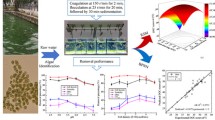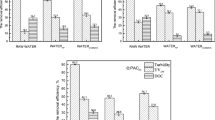Abstract
It was aimed to precisely investigate the coagulation properties of graphene oxide (GO) as a novel coagulant for turbidity removal from water. For this purpose, the process was simulated through response surface methodology (RSM) to determine the effect of the preselected independent factors (pH, GO dosage, and initial turbidity) and their interaction effects on the process. Based on the results, increased turbidity removal efficiencies were obtained as pH decreased from 10 to 3. Besides, increase of GO dosage within the test range (2.5–30 mg/L) was highly beneficial for enhancing the process performance. However, a slight overdosing of GO was observed for dosages of more than 20 mg/L under pH values of less than about 4. For initial turbidity with test range of 25–300 NTU, there was an optimum range (approximately 120–200 NTU) out of which the removal efficiency declined. According to the results of the analysis of variance (ANOVA), pH and GO dosage, orderly, had the strongest individual effect on the process performance. The most significant interaction effect was also observed between pH and GO dosage. The optimal coagulation conditions with GO dosage of 4.0 mg/L, pH of 3.0, and initial turbidity of 193.34 NTU led to a turbidity removal efficiency of about 98.3%, which was in good agreement with RSM results. Under basic pH levels, the sweeping effect was recognized as the main coagulation mechanism occurred between the negatively surface charged particles of GO and soil. However, according to zeta potential (ZP) analysis results, under acidic pH conditions in addition to the sweep coagulation, the electric double layer compression, and the subsequent ZP reduction also contributed significantly to the process. Scanning electron microscopy (SEM) images showed that the layered structure of GO particles provided an appropriate platform on which the flocs were formed.










Similar content being viewed by others
Data availability
All the needed data are provided in the manuscript.
References
Aboubaraka AE, Aboelfetoh EF, Ebeid EZM (2017) Coagulation effectiveness of graphene oxide for the removal of turbidity from raw surface water. Chemosphere 181:738–746. https://doi.org/10.1016/j.chemosphere.2017.04.137
Adesina OA, Abdulkareem F, Yusuff AS, Lala M, Okewale A (2019) Response surface methodology approach to optimization of process parameter for coagulation process of surface water using Moringa oleifera seed. S Afr J Chem Eng 28:46–51. https://doi.org/10.1016/j.sajce.2019.02.002
Altaher H (2012) The use of chitosan as a coagulant in the pre-treatment of turbid sea water. J Hazard Mater 233:97–102. https://doi.org/10.1016/j.jhazmat.2012.06.061
Anouzla A, Abrouki Y, Souabi S, Safi M, Rhbal H (2009) Colour and COD removal of disperse dye solution by a novel coagulant: application of statistical design for the optimization and regression analysis. J Hazard Mater 166:1302–1306. https://doi.org/10.1016/j.jhazmat.2008.12.039
Aslani H, Nabizadeh R, Nasseri S, Mesdaghinia A, Alimohammadi M, Mahvi AH, Rastkari N, Nazmara S (2016) Application of response surface methodology for modeling and optimization of trichloroacetic acid and turbidity removal using potassium ferrate (VI). Desalin Water Treat 57:25317–25328. https://doi.org/10.1080/19443994.2016.1147380
Baghvand A, Zand AD, Mehrdadi N, Karbassi A (2010) Optimizing coagulation process for low to high turbidity waters using aluminum and iron salts. Am J Environ Sci 6:442–448. https://doi.org/10.3844/ajessp.2010.442.448
Bolt GH (1976) Adsorption of anions by soil. Dev Soil Sci 5:91–95. https://doi.org/10.1016/S0166-2481(08)70634-2
Daud NM, Sheikh Abdullah SR, Abu Hasan H (2018) Response surface methodological analysis for the optimization of acid-catalyzed transesterification biodiesel wastewater pre-treatment using coagulation–flocculation process. Process Saf Environ 113:184–192. https://doi.org/10.1016/j.psep.2017.10.006
Divakaran R, Pillai VS (2002) Flocculation of river silt using chitosan. Water Res 36:2414–2418. https://doi.org/10.1016/S0043-1354(01)00436-5
Guo B, Yu H, Gao B, Rong H, Dong H, Ma D, Li R, Zhao S (2015) Coagulation performance and floc characteristics of aluminum sulfate with cationic polyamidine as coagulant aid for kaolin-humic acid treatment. Colloids and Surfaces A: Physicochemical and Engineering Aspects 48:476–484. https://doi.org/10.1016/j.colsurfa.2015.06.017
Hiew BYZ, Lee LY, Lai KC, Gan S, Thangalazhy-Gopakumar S, Pan GT, Yang TCK (2019) Adsorptive decontamination of diclofenac by three-dimensional graphene-based adsorbent: response surface methodology, adsorption equilibrium, kinetic and thermodynamic studies. Environ Res 168:241–253. https://doi.org/10.1016/j.envres.2018.09.030
Huang X, Zhao Y, Gao B, Sun S, Wang Y, Li Q, Yue Q (2016) Polyacrylamide as coagulant aid with polytitanium sulfate in humic acid-kaolin water treatment: effect of dosage and dose method. J Taiwan Inst Chem Eng 64:173–179. https://doi.org/10.1016/j.jtice.2016.04.011
Hummers WS Jr, Offeman RE (1958) Preparation of graphitic oxide. J Am Chem Soc 80:1339. https://doi.org/10.1021/ja01539a017
Jefferson B, Sharp EL, Goslan E, Henderson R, Parsons SA (2004) Application of charge measurement to water treatment processes. Water Sci Technol: Water Supply 4:49–56. https://doi.org/10.2166/ws.2004.0092
Jiang JQ (2015) The role of coagulation in water treatment. Curr Opin Chem Eng 8:36–44. https://doi.org/10.1016/j.coche.2015.01.008
Jiang JQ, Wang HY (2009) Comparative coagulant demand of polyferric chloride and ferric chloride for the removal of humic acid. Sep Sci Technol 44:386–397. https://doi.org/10.1080/01496390802590020
Jin L, Chai L, Ren L, Jiang Y, Yang W, Wang S, Liao Q, Wang H, Zhang L (2019) Enhanced adsorption-coupled reduction of hexavalent chromium by 2D poly (m-phenylenediamine)-functionalized reduction graphene oxide. Environ Sci Pollut Res 26:31099–31110. https://doi.org/10.1007/s11356-019-06175-x
Kang M, Kameib T, Magarab Y (2003) Comparing polyaluminum chloride and ferric chloride for antimony removal. Water Res 37:4171–4179. https://doi.org/10.1016/S0043-1354(03)00351-8
Kirmizakis P, Tsamoutsoglou C, Kayan B, Kalderis D (2014) Subcritical water treatment of landfill leachate: application of response surface methodology. J Environ Manage 146:9–15. https://doi.org/10.1016/j.jenvman.2014.04.037
Krishnan S, Zulkapli NS, Din MFM, Majid ZA, Honda M, Ichikawa Y, Sairan FM, Nasrullah M, Guntor NAA (2020) Statistical optimization of titanium recovery from drinking water treatment residue using response surface methodology. J Environ Manage 255:109890. https://doi.org/10.1016/j.jenvman.2019.109890
Li Z, Chen F, Yuan L, Liu Y, Zhao Y, Chai Z, Shi W (2012) Uranium (VI) adsorption on graphene oxide nanosheets from aqueous solutions. Chem Eng J 210:539–546. https://doi.org/10.1016/j.cej.2012.09.030
Liu G, Han K, Ye H, Zhu C, Gao Y, Liu Y, Zhou Y (2017) Graphene oxide/triethanolamine modified titanate nanowires as photocatalytic membrane for water treatment. Chem Eng J 320:74–80. https://doi.org/10.1016/j.cej.2017.03.024
Metcalf & Eddy (2003) Wastewater engineering: treatment and reuse, 4th edn. McGraw-Hill, New York
Montgomery DC (2001) Design and analysis of experiments, 5th edn. John Wiley & Sons, New York
Mora BP, Bellú S, Mangiameli MF, Frascaroli MI, González JC (2019) Response surface methodology and optimization of arsenic continuous sorption process from contaminated water using chitosan. J Water Process Eng 32:100913. https://doi.org/10.1016/j.jwpe.2019.100913
Myers RH, Montgomery DC, Anderson-Cook CM (2009) Response surface methodology: process and product optimization using designed experiments, 3rd edn. John Wiley & Sons, New York
Nourani M, Baghdadi M, Javan M, Bidhendi GN (2016) Production of a biodegradable flocculant from cotton and evaluation of its performance in coagulation-flocculation of kaolin clay suspension: Optimization through response surface methodology (RSM). J Environ Chem Eng 4:1996–2003. https://doi.org/10.1016/j.jece.2016.03.028
Ooi TY, Yong EL, Din MF, Rezania S, Aminudin E, Chelliapan S, Rahman AA, Park J (2018) Optimization of aluminium recovery from water treatment sludge using response surface methodology. J Environ Manage 228:13–19. https://doi.org/10.1016/j.jenvman.2018.09.008
Park S, Ruoff RS (2009) Chemical methods for the production of graphenes. Nat Nanotechnol 4:217–224. https://doi.org/10.1038/nnano.2009.58
Qasim SR, Motley EM, Zhu G (2002) Water works engineering: planning design and operation, 1st ed., prentice Hall
Ramesha G, Kumara AV, Muralidhara H, Sampath S (2011) Graphene and graphene oxide as effective adsorbents toward anionic and cationic dyes. J Colloid Interface Sci 361:270–277. https://doi.org/10.1016/j.jcis.2011.05.050
Reynolds TD, Richards PA (1996) Unit operations and processes in environmental engineering, 2nd edn. PWS Publishing Company, Boston
Rizzo L, Belgiomo V, Gallo M, Meric S (2005) Removal of THM precursors from a high-alkaline surface water by enhanced coagulation and behaviour of THMFP toxicity on D. magna. Desalination 176:177–188. https://doi.org/10.1016/j.desal.2004.10.020
Rizzo L, Di Gennaro A, Gallo M, Belgiorno V (2008) Coagulation/chlorination of surface water: a comparison between chitosan and metal salts. Sep Purif Technol 62:79–85. https://doi.org/10.1016/j.seppur.2007.12.020
Robati D, Mirza B, Rajabi M, Moradi O, Tyagi I, Agarwal S, Gupta V (2016) Removal of hazardous dyes-BR 12 and methyl orange using graphene oxide as an adsorbent from aqueous phase. Chem Eng J 284:687–697. https://doi.org/10.1016/j.cej.2015.08.131
Sadri Moghaddam S, Alavi Moghaddam M, Arami M (2011) Response surface optimization of acid red 119 dye from simulated wastewater using Al based waterworks sludge and polyaluminium chloride as coagulant. J Environ Manage 92:1284–1291. https://doi.org/10.1016/j.jenvman.2010.12.015
Sanchez VC, Jachak A, Hurt RH, Kane AB (2011) Biological interactions of graphene-family nanomaterials: an interdisciplinary review. Chem Res Toxicol 25:15–34. https://doi.org/10.1021/tx200339h
Simate GS, Iyuke SE, Ndlovu S, Heydenrych M (2012) The heterogeneous coagulation and flocculation of brewery wastewater using carbon nanotubes. Water Res 46:1185–1197. https://doi.org/10.1016/j.watres.2011.12.023
Sparks DL (2002) Environmental Soil Chemistry, 2nd ed., Academic Press
Stevenson FJ (1994) Humus chemistry: genesis, composition, reactions, 2nd ed., John Wiley & Sons, New York
Tan P, Bi Q, Hu Y, Fang Z, Chen Y, Cheng J (2017) Effect of the degree of oxidation and defects of graphene oxide on adsorption of Cu2+ from aqueous solution. Appl Surf Sci 423:1141–1151. https://doi.org/10.1016/j.apsusc.2017.06.304
Trinh TK, Kang LS (2011) Response surface methodological approach to optimize the coagulation–flocculation process in drinking water treatment. Chem Eng Res Des 89:1126–1135. https://doi.org/10.1016/j.cherd.2010.12.004
Van Benschoten JE, Edzwald JK (1990) Chemical aspects of coagulation using aluminum salts i. hydrolytic reactions of alum and polyaluminum chloride. Water Res 24(12):1519–1526. https://doi.org/10.1016/0043-1354(90)90086-L
Yang ZL, Gao BY, Yue QY, Wang Y (2010) Effect of pH on the coagulation performance of Al-based coagulants and residual aluminum speciation during the treatment of humic acid–kaolin synthetic water. J Hazard Mater 178:596–603. https://doi.org/10.1016/j.jhazmat.2010.01.127
Yang ST, Chen S, Chang Y, Cao A, Liu Y, Wang H (2011) Removal of methylene blue from aqueous solution by graphene oxide. J Colloid Interface Sci 359:24–29. https://doi.org/10.1016/j.jcis.2011.02.064
Yang X, Chen C, Li J, Zhao G, Ren X, Wang X (2012a) Graphene oxide-iron oxide and reduced graphene oxide-iron oxide hybrid materials for the removal of organic and inorganic pollutants. RSC Adv 2:8821–8826. https://doi.org/10.1039/C2RA20885G
Yang Z, Yuan B, Huang X, Zhou J, Cai J, Yang H, Li A, Cheng R (2012b) Evaluation of the flocculation performance of carboxymethyl chitosan-graft-polyacrylamide, a novel amphoteric chemically bonded composite flocculant. Water Res 46:107–114. https://doi.org/10.1016/j.watres.2011.10.024
Yang Z, Yan H, Yang H, Li H, Li A, Cheng R (2013) Flocculation performance and mechanism of graphene oxide for removal of various contaminants from water. Water Res 47:3037–3046. https://doi.org/10.1016/j.watres.2013.03.027
Zhang HF, Sun BS, Zhao XH, Gao ZH (2008) Effect of ferric chloride on fouling in membrane bioreactor. Sep Purif Technol 63:341–347. https://doi.org/10.1016/j.seppur.2008.05.024
Zhao G, Jiang L, He Y, Li J, Dong H, Wang X, Hu W (2011a) Sulfonated graphene for persistent aromatic pollutant management. Adv Mater 23:3959–3963. https://doi.org/10.1002/adma.201101007
Zhao G, Li J, Ren X, Chen C, Wang X (2011b) Few-layered graphene oxide nanosheets as superior sorbents for heavy metal ion pollution management. Environ Sci Technol 45:10454–10462. https://doi.org/10.1021/es203439v
Zhao Z, Sun W, Ray MB, Ray AK, Huang T, Chen J (2019) Optimization and modeling of coagulation-flocculation to remove algae and organic matter from surface water by response surface methodology. Front Environ Sci Eng 13(5):75. https://doi.org/10.1007/s11783-019-1159-7
Zhu G, Zheng H, Zhang Z, Tshukudu T, Zhang P, Xiang X (2011) Characterization and coagulation–flocculation behavior of polymeric aluminum ferric sulfate (PAFS). Chem Eng J 178:50–59. https://doi.org/10.1016/j.cej.2011.10.008
Acknowledgments
The authors gratefully acknowledge the Iran University of Science and Technology (IUST) for its financial supports and providing the research materials and equipment.
Funding
The research was financially supported by Iran University of Science and Technology (IUST) through the research budgets of the university.
Author information
Authors and Affiliations
Contributions
Hasani Zonoozi and Saadatpour supervised the study and planed and designed the research; Rezania carried out the tests and chemical analyses; All authors conducted statistical analysis; All authors participated in the writing, reading, and approving the manuscript.
Corresponding author
Ethics declarations
Competing Interests
The authors declare that they have no competing interests.
Ethics approval
Not applicable
Consent to participate
Not applicable
Consent for publication
Not applicable
Additional information
Responsible editor: Tito Roberto Cadaval Jr
Publisher’s note
Springer Nature remains neutral with regard to jurisdictional claims in published maps and institutional affiliations.
Rights and permissions
About this article
Cite this article
Rezania, N., Hasani Zonoozi, M. & Saadatpour, M. Coagulation-flocculation of turbid water using graphene oxide: simulation through response surface methodology and process characterization. Environ Sci Pollut Res 28, 14812–14827 (2021). https://doi.org/10.1007/s11356-020-11625-y
Received:
Accepted:
Published:
Issue Date:
DOI: https://doi.org/10.1007/s11356-020-11625-y




